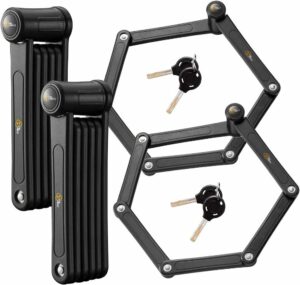How to store your E-Bike for the winter.
Key Takeaways
- Indoor Storage: Whenever possible, store your e-bike indoors to shield it from extreme temperatures and inclement weather.
- Battery Care: Charge the battery to 50-70% before storage and store it in a cool, dry place. Periodically check and give it a quick charge if needed.
- Protect Electrical Components: Keep your e-bike in a dry place to prevent water damage. Consider removing the battery and using a water-resistant cover for additional protection.
- Frame Maintenance: Clean your e-bike thoroughly before storage, lubricate moving parts, and check brake pads to prevent corrosion and damage.
- Regular Riding: If your e-bike won’t be stored for more than two weeks, keep the battery partially charged with occasional short rides.
- Winter Haven: With these storage tips, your e-bike can rest comfortably during the winter and be ready to ride once spring arrives.
- Maintenance Ahead: Stay tuned for the next section, where we’ll explore the essential maintenance practices to revive your e-bike after its winter hiatus.

Preparing Your Electric Bike for Winter Storage
As winter’s chilly embrace approaches, the question of how to best store your electric bike becomes essential. Proper winter storage ensures that your e-bike remains in top condition during the cold months and is road-ready when spring arrives. In this guide, we’ll explore effective strategies to safeguard your e-bike from the harsh effects of winter, from protecting the battery to preserving the frame. Let’s dive into the world of winter e-bike storage.
The Basics of Winter E-Bike Storage
As winter sets in and outdoor riding becomes less enticing, it’s crucial to ponder the fate of your beloved electric bike. While e-bikes are engineered to handle a variety of conditions, the combination of extreme temperatures and unpredictable winter weather can pose risks to their delicate components. Thus, the decision of where to store your e-bike during this season warrants careful consideration.
Indoor vs. Outdoor Storage: Weighing the Options
Before you make a choice, evaluate the pros and cons of indoor and outdoor storage for your e-bike. While e-bikes are generally built to endure the elements, winter’s icy grip can challenge even the hardiest of designs. The freezing temperatures, moisture, and salt on the roads can lead to rust, corrosion, and accelerated wear. This holds true for both the frame and the electrical components of your e-bike.
The Indoor Advantage: Shielding Your E-Bike from the Elements
Whenever possible, indoor storage is the optimal choice. Parking your e-bike indoors not only safeguards it from the harsh winter weather but also extends its longevity. A dry and relatively temperature-stable environment is your e-bike’s best friend. An indoor spot shields your e-bike from snow, rain, and freezing winds, all of which can hasten the wear and tear process.

Consider a corner in your garage, a dedicated storage shed, or even a spare room where your e-bike can safely hibernate. If indoor storage isn’t feasible due to space limitations, investing in a weatherproof cover can provide some degree of protection. However, keep in mind that even with a cover, outdoor storage is a compromise that might expose your e-bike to unnecessary risks.
In the following sections, we will delve deeper into the specifics of winter e-bike storage, from preserving your battery’s charge to ensuring the structural integrity of your bike frame. By taking the necessary precautions, you can ensure that your e-bike emerges from the winter months ready to hit the road without any hiccups.
Battery Care: The Heart of Your E-Bike
When it comes to your e-bike’s winter hiatus, proper care for the battery is essential. The battery is not only the powerhouse of your electric bike but also a sensitive component that requires special attention, especially in colder conditions. Follow these steps to ensure that your e-bike’s battery remains in prime condition, ready to deliver optimal performance once the snow melts away:
Charge to the Sweet Spot:
Before you tuck your e-bike and its battery away for winter, ensure that the battery charge hovers around 50-70%. This charge level strikes a balance – it prevents the battery from fully discharging, which can cause damage, and also avoids maintaining it at a full charge, which can lead to quicker degradation during prolonged inactivity.
Seek a Sheltered Spot:
Choose a storage location that mirrors the battery’s preferences: cool and dry. Avoid exposing the battery to extreme cold or heat, both of which can harm its chemical composition and overall performance. Basements, garages, or even a closets inside your home can serve as suitable storage spots.
Separate for Safety:
If possible, remove the battery from your e-bike before storing it. This simple step helps prevent any unnecessary wear on the battery contacts and ensures that the electrical components remain unaffected by winter’s chill.
Monitor and Maintain:
Though your e-bike might be taking a break, the battery shouldn’t be completely forgotten. Periodically check the battery’s charge level throughout the winter months. If you notice a significant drop in charge, it’s a good idea to give it a quick charge to maintain its health. This can be particularly important if you’re planning to embark on a winter adventure.
Your e-bike’s battery is a sophisticated piece of technology, and a little care during the winter can go a long way in preserving its capacity and lifespan. In the following sections, we’ll address more aspects of winter e-bike storage, including protecting the frame and tires from the elements, ensuring smooth operation post-storage, and maintaining overall e-bike health.
Protecting Electrical Components
Your e-bike’s electrical components play a pivotal role in its operation, and they can be sensitive to the harsh conditions of winter. Here’s how to shield these essential elements from the cold’s grip and moisture’s intrusion:
Seek a Dry Sanctuary:
Just as you prefer a dry shelter during a rainy day, your e-bike’s electrical components crave the same protection. Choose a storage spot that is dry, such as a garage or shed, to prevent water damage and minimize the risk of moisture infiltrating sensitive electronics.
Separate to Safeguard:
If you’re considering storing your e-bike for an extended period, it might be a prudent move to remove the battery. This step helps prevent the possibility of corrosion, which can gradually take a toll on the battery contacts and other electrical connections.
Wrap in a Protective Veil:
For an added layer of defense against moisture, consider using a neoprene cover or a similar water-resistant covering. This shield can effectively guard the electrical components from the elements, ensuring that they remain dry and operational.
By offering these measures of protection to your e-bike’s electronic brain, you’re not only prolonging its life but also ensuring that it’s ready to hit the road once the winter spell is broken. In the upcoming sections, we’ll continue to explore strategies to keep your e-bike in impeccable condition during winter storage, including tips on maintaining the frame, wheels, and other essential components.
Tending to the Frame and Other Components
Just as you’d wrap yourself in warm layers during the cold season, your e-bike’s frame and components also need some TLC to weather the winter months without a hitch. Here are some valuable tips to keep your e-bike in prime condition while it’s in hibernation:
A Clean Start for Winter:
Before you tuck your e-bike away for the winter, give it a thorough cleaning. This pre-storage spa treatment removes accumulated dirt, grime, and even salt – a common wintertime road companion – that could otherwise trigger corrosion during the chilly months. A clean slate is the first step in ensuring your e-bike’s pristine condition when spring beckons.
Lubrication for Protection:
Just as the winter wind can dry out your skin, it can also impact your e-bike’s moving parts. Apply a gentle layer of lubrication to components like the chain and derailleurs. This preventive measure not only staves off rust but also guarantees a smooth operation when the blossoms return. Remember, a little lubrication goes a long way in preserving your e-bike’s efficiency.
Brake Pad Check:
Don’t overlook your brake pads. These unassuming components play a crucial role in your e-bike’s safety. Check their condition and replace them if they’re worn down. Worn brake pads not only compromise your ability to stop effectively but can also damage your wheels, especially during prolonged storage. Ensuring your brakes are road-ready is a must before you stow your e-bike away.
By embracing these steps, you’re not just maintaining your e-bike’s aesthetics; you’re nurturing its core, ensuring that when the frost melts away, your two-wheeled companion will be ready to hit the road without missing a beat. Our journey through winter e-bike storage continues as we dive into the specifics of protecting your e-bike’s wheels, maintaining the tires, and preparing for the eventual return of sunny rides.
The Importance of Regular Riding
In the world of e-bikes, as in life, activity breeds vitality. If your plan involves storing your e-bike for a span not exceeding two weeks, a key strategy for maintaining battery health is to keep it partially charged. Let’s delve into the reasons behind this practice and the benefits it brings to your e-bike’s longevity.

Battling Capacity Loss:
Just as muscles weaken with inactivity, your e-bike’s battery can experience capacity loss if left fully discharged for extended periods. Capacity loss is akin to a diminishing energy reservoir; your battery’s ability to hold a charge diminishes over time, resulting in reduced mileage and overall performance. By maintaining a partial charge, you’re essentially giving your battery a workout, helping it retain its capacity and maximizing its lifespan.
Keeping the Systems Engaged:
Think of your e-bike as a finely tuned orchestra; each component plays a role in harmony. Regular riding ensures that all systems are engaged and functioning optimally. A quick spin every couple of weeks keeps the electrical and mechanical components active, preventing them from slipping into a state of dormancy. This proactive approach ensures that when you’re ready to hop back on your e-bike, it responds with the same zippy enthusiasm.
A Winter Adventure:
Embracing a short winter ride also offers you a chance to experience the beauty of winter landscapes from a unique perspective. The crisp air, the quiet serenity, and the invigorating chill can add a touch of adventure to your routine. It’s not just about maintaining your e-bike; it’s also about nourishing your spirit with a refreshing spin, even in the heart of winter.

Remember, even during the colder months, your e-bike thrives on attention and activity. By following this practice of partial charging and occasional rides, you’re not only safeguarding your investment but also ensuring that your e-bike remains an ever-ready companion, eager to hit the road whenever you are. As we continue our journey through the intricacies of winter e-bike storage, we’ll explore the nuances of protecting your e-bike against the threats of moisture and the potential challenges posed by extreme cold.
FAQs and Storing Electric Bikes over Winter
- Q: How often should I check my e-bike’s battery charge during winter storage?
- Q: Can I store my electric bike outside if I don’t have indoor space?
A: Indoor storage is recommended. If outdoor storage is your only option, use a weatherproof cover to protect your bike, though this is not as effective as indoor storage.
- Q: Is it necessary to remove the battery for winter storage?
- Q: How should I clean my e-bike before storing it for the winter?
- Q: Can I leave my electric bike’s battery in a fully charged state over the winter?
- Q: What should I do if my e-bike will be stored for more than two weeks?
A: Even if stored for longer periods, it’s beneficial to give it a short ride or at least turn it on occasionally to keep the battery and components in good condition.
A: Periodically check the battery’s charge level throughout the winter. If you notice a significant drop, give it a quick charge to maintain its health.
A: Yes, removing the battery can help prevent unnecessary wear on the contacts and protect it from extreme temperatures.
A: Give your e-bike a thorough cleaning to remove dirt, grime, and salt, which can cause corrosion. Also, lubricate moving parts to prevent rust.
A: No, it’s best to keep the battery charged to 50-70% to prevent damage from full discharge or potential degradation from being fully charged.
Ensuring Your E-Bike's Winter Rest
As winter casts its icy spell and the world transforms into a frosty wonderland, your trusty e-bike deserves a season of repose. With these storage insights in your arsenal, you’re setting the stage for a seamless transition when the first signs of spring start to appear. By adhering to these precautions and nurturing your e-bike’s well-being, you’re securing its readiness to roll when the thaw arrives.
Remember, a little extra care today ensures your e-bike’s vibrant performance tomorrow. Just as nature takes its rest during winter, your e-bike too can benefit from a season of respite, emerging stronger and more ready than ever. In our next section, we’ll delve into the art of awakening your e-bike from its winter slumber and guiding it through a springtime revival. Stay tuned for essential maintenance practices to kick-start your e-bike’s journey into the warmer days ahead.








